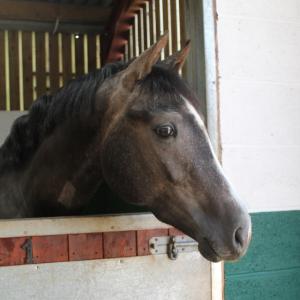
By Vet Bethan Harper
Choke is a fairly common condition affecting horses which is caused by an obstruction of the oesophagus, which carries food to the stomach.
This is often due to fibre feeds such as sugarbeet that have been improperly soaked prior to feeding, allowing them to expand in the oesophagus.
Choke may also occur due to inadequate chewing, for example in horses with dental problems, or horses that rush their food. Rarely, choke can be caused by a foreign body such as a piece of stick.

Horses with choke usually present with a green frothy discharge from their nose and will appear to be retching with their neck stretched out. Other signs include coughing, drooling, lack of interest in food, and difficulty swallowing. Occasionally, a lump may be seen or felt in the left side of the neck.
Although it appears quite dramatic when horses present with these signs, choke is rarely life threatening and, in many cases, will resolve itself with no intervention.
If you think your horse is choking, remove all food from them and stay with them to monitor and keep them calm. If they become very distressed, or if the choke lasts longer than 30 minutes then they will need to be seen by a vet. As always, if you are concerned, it is best to call your vet for advice.
If the vet attends your horse, following an initial exam, often the first thing they will do is give some sedation. This will reduce anxiety and relax the oesophagus, making it easier for the obstruction to pass. Sedation also causes horses to lower their heads, which is beneficial to reduce the likelihood of them inhaling saliva or food material. A nasogastric tube is then passed through the nose into the oesophagus and advanced until the obstruction prevents further passage. The tube not reaching the stomach confirms the diagnosis of choke. At this point, water can be instilled through the tube to gently lavage and soften the obstruction.
It is important to keep the head low while lavaging to prevent water entering the trachea and lungs. Patience is key with these cases as it may take a while to dislodge the obstruction.
In most cases, a simple lavage will be enough to resolve the problem, but if the obstruction persists it may be necessary to admit your horse for a further workup which will allow your vet to plan the best way to remove it.
Following an episode of choke, it is best to withhold food for up to 12 hours. This will allow time for any swelling to reduce, which reduces the risk of another choke. Fresh water should still be available at all times.
After this period, food should be reintroduced slowly, starting with a soft sloppy mash. Over the next 24-48 hours the normal diet should be added back in slowly to resume their normal routine.
The most common consequence of choke is inflammation of the oesophagus, causing pain. Depending on your vet’s assessment, and the length of time the horse was choking, anti-inflammatory painkillers may be prescribed.
More severe consequences are less common but may include the formation of a stricture (narrowing) in the oesophagus, or aspiration pneumonia. Aspiration pneumonia is caused by the inhalation of saliva and food material into the lungs, which is why keeping the head low is so important. If your vet suspects this may have occurred, they will prescribe a course of antibiotics.
It is worth monitoring your horse for a few days following an episode of choke to watch out for signs of pneumonia (increased respiratory rate/effort, increase in rectal temperature).